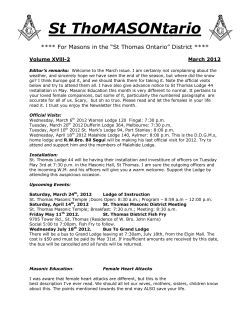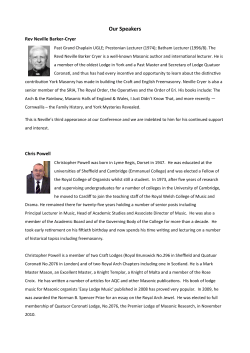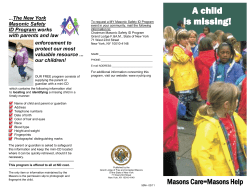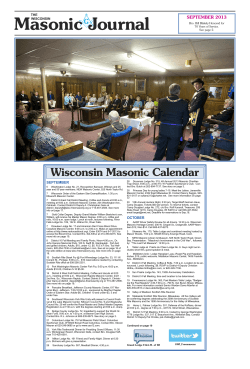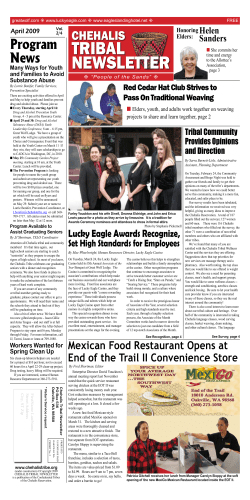
Document 31852
Gems of Purpose Volume 3, Issue 2 March 2008 Bethpage Lodge #521, F&AM of Tennessee Dr. David E. Stafford, PM-Sec’y Douglas Stinson, Worshipful Master 550 E. Bledsoe Street, 23-B [email protected] www.mastermason.com/bethpagelodge521 Gallatin, TN 37066 www.grandlodge-tn.org/ Helping Brother Billy Special points of interest: • March 10—2 EA Degrees at Bethpage, eat at 6:00 work at 7 pm. • March 20—Stated Meeting @ 7 pm • March 26 & 27—Grand Communication at the Grand Lodge Building. • April 17—Stated Meeting @ 7 pm. Bethpage Lodge, with the assistance of Grace Baptist Church, recently raised over $11,000 for a brother in need. Brother Billy Burrough’s wife, Betty, has been in critical care at University of Maryland Medical Center for almost three months. She has had a heart pump placed in her heart and has experienced complications. We ask that everyone continue to keep her in your prayers. Brother Billy is doing well, and he has been visited by several brothers belonging to lodges in Maryland. These brothers have helped Billy tremendously, and Bethpage Lodge extends our personal appreciation for their assistance to Brother Billy. The photo below shows Brother Billy, in the middle, with two Maryland Masons. Brother Howard W. Trott from Glen Burnie Lodge #213 and Annapolis Lodge #89 is on Brother Billy’s left and Brother Richard Osborn, from Annapolis Lodge #89, is on Brother Billy's right. It is wonderful to be a part of a fraternity that has no territorial bounds to brotherhood. ∞ Inside this issue: Brother Billy 1 Cookie Cutter Lodge 2 Cookie Cutter Conti. 3 Cookie Cutter Conti. 4 Maundy Thursday 4 About Us 5 From Left to Right: Brother Trott, Brother Billy, and Brother Osborn Gems of Purpose Page 2 Cookie Cutter Lodges Dr. David E. Stafford, PM-Sec’y I was recently asked what I saw as the leading problem in Masonry. Since the question was asked, I have spent a lot of time in meditation and reflection about what I see occurring in Tennessee Masonry. The main problem I see is one that was begun several generations ago. Tennessee, like so many other jurisdictions, has streamlined Masonry. It was once thought of as a great way to improve the Craft, but I believe an examination of our current position would reveal it has done harm and all but removed the charm of many of our local lodges. The most positive aspect of streamlined Masonry is the consistency of the ritual. Every EA degree conferred under the auspice of the Grand Lodge of Tennessee, in theory, is identical. This allows a brother from Kingsport Lodge #688 to assist Memphis Lodge #118 with no joint practice. Very convenient. This has become very beneficial to struggling rural lodges who rely on each other for assistance. The negative has come from the mentality it has established. So many of our fellow Masons expect for every lodge in the state of Tennessee do everything exactly the same, and for the most part we do. Local blue lodges have either lost their individuality or they never developed an independent culture because it is viewed as being “not the way” everyone else does it. Today about the only peculiarity one lodge has from another is perhaps they way they vote at the ballot box. In some lodges, the brethren line up and individually approach the alter, salute the box, and vote. Some lodges pass the ballot box around the room, each member remains seated, and drops the ball of his choice. At Bethpage Lodge, we give full control of the ballot box to the Senior Deacon who selects the order of how the lodge votes. He places the box on the alter and points and calls the members from their seats to vote in the order he pleases. He usually begins with the Worshipful Master and works down the line to the members and ends with either the himself or the Tiler voting. There is neither a right nor a wrong way to pass the ballot for voting, but it is these little difference that make each lodge unique. Bethpage Lodge also has a unique tradition before participating in a Masonic Funeral Service for a brother. At some period before the lodge conducts the last Masonic Rites, a few members of the lodge meet at the hall. They will drape the alter with a black cloth and will turn the staffs. Our staffs are bi-colored, one-half white and one-half black. When we turn the staffs for the funeral, the black end will be pointed to the ceiling. This is a tradition that has been carried on for many generations. Is it common? No, but it is our lodge’s way of showing additional respect for our departed brother. It is the embracing of these local traditions and forms that make each lodge unique. Unfortunately, in our world of fast food, fast service, and fast Masonry these elements of individuality are overlooked and have been, for the most part, dispensed with in most lodges. Freemasonry has so much to offer to the men of the present generation; however, as long as we serve Masonry in the fast food style we are not offering something unique. In this world of Wal-Mart, McDonald’s, and Starbucks we have all come to expect more for less. We constantly look for the cheapest prices and we give very little thought to the quality of items. We only look at quantity and how inexpensive it is. Consider your lodge’s work. It seems as though we are all looking for ways to increase the number of men petitioning the lodge. The cost of joining Bethpage Lodge, and most likely your lodge too, has increased very little over the past twenty or thirty years, but the quality of the experience has probably suffered. At most degrees, lodges seem to have a fast pot-luck meal on paper plates, coffee from Styrofoam cups, cokes in a can, and an assemble line approach to making a plate that resembles the all-you-can buffets in Vegas. The candidate is then left to prepare as the lodge is opened. During the degree, mistakes are made, and it is almost always assuredly promised that someone on the sidelines is going to try to correct every word that is mispronounced during the degree. (That is distasteful by the way. Correct a brother during practice but never in front of a candidate). The degree ends, and the candidate is given a few minutes to speak. If it is his third degree he is presented with his apron and dues card. He is then left to himself, maybe to return to the lodge at the stated meeting, maybe not. It matters little to many, as long as he pays his $50.00 in dues each year. Is that streamlined? Is it regal and majestic? (The answers are yes to the first question and no to the second, if you were having difficulty.) Most every lodge in the state follows this cookie cutter form of practice. We all look just a like. I have been to degrees all over the state. In lodges with men in bibbed overalls and in lodges made up of men in suits and ties, but the result seems to almost always be the same. A cookie cutter experience. Continued on page 4 (Cookie Cutter) . . . . Volume 3, Issue 2 Page 3 Cookie Cutter, from page 2 What is wrong with this? In my professional life, I have spent a great deal of time in study and examination into what makes organizations successful. Through my academic pursuits, I have found there are commonalities shared between successful organizations, of all types. They have a sense of purpose. They are driven by a desire to excel. They have vision. They have uniqueness and members with a strong sense of belonging. There are hundreds of books and articles that support these few assertions. If interested, I could point you in their direction. It is not suggested that these named are the only characteristics of organizations that succeed. It is only suggested that these are a few of the many characteristics that are most commonly attributed to organizations that rise above the norm. Let us now compare Freemasonry to these qualities: 1. What is the purpose of Freemasonry? I suppose the most common answer to this question is to take good men and make them better. That is a noble mission, but it is extremely vague and ambiguous. It leaves many questions to the imagination. One of which is, What does Masonry have to offer to make men better? Well, the truth is that for most men who join the lodge, the ritual they experience while taking their degrees is about it. Now do not get me wrong. The Masonic ritual, as used in Tennessee, is beautiful and moving, but the true meaning and deeper gems of purpose are only revealed and understood after a great deal of study and reflection on the history, philosophy, and esoteric teaching of the Craft. Most men who join the lodge never take a serious look at the meaning of the rituals in which they participated. I propose that the true purpose of Masonry is to improve men through the bonds formed between brothers of the mystic tie and Masonic Education. The latter of which has been so lost in the streamlining of Masonry that there is only barely a glimpse of it visible today. 2. Organizations that are successful have a zeal to excel. In what do we, as masons, attempt to excel? Most often, if anything, it is the performance of ritual. Once again, I have no problem with ritual. I enjoy working in degrees, and I am an advocate of performing lodge ritual in a formal, sacred, and sincere manner. However, conferring of degrees is only the beginning of Freemasonry. We, as Tennessee Masons, reward brethren for exemplary work in ritual. We reward lodges for having officers that are proficient in ritual. We do not reward lodges for having exemplary education programs or for embracing their individuality and tradition. In general, there is only one aspect of Freemasonry in which we reward ourselves for excelling. Streamlining of Freemasonry has led us to only excel in one aspect of Masonry and neglect the rest. (The only possible exception is in charity. After all, American Freemasonry has become more of a service club than a secret society or fraternity.) 3. Organizations that are successful must have vision. The Grand Lodge of Tennessee has done a wonderful job establishing and creating a central vision. The 2013 Program has potential to be a driving force in Freemasonry; however, we have seen very little buy in on a local level. Too often local lodges work on a month to month basis. They have no long term goal, and they offer very little to the brother who is not an avid ritualist. I propose that every lodge should develop a vision to offer educational programs to their members. Each lodge should have at least quarterly programs that delve into the spiritual, esoteric, philosophical, or theological aspect of the Craft. At these meetings, the lodge should have a meal and an opportunity to socialize and enjoy each others company. That is where Freemasonry can be found. 4. Organizations that experience growth and success are unique. I have already tried to express the lack of uniqueness from one lodge to another. I am an advocate of the idea of finding what is unique about the group of brothers that make up your lodge and build on that. I read of many innovative and prosperous lodges who have set up the idea of a theme. In California there is a lodge that embraces members musical talents and interests. There are lodges in the United States that embrace scholarly research and discussion. Why can we not develop lodges with uniqueness? It does not require the forming of new lodges, only the examination of what is unique about your lodge. Develop a program that meets the interest of the members of your lodge. It does not have to be grandiose, only unique. Continued on page 5 (Cookie Cutter) . . . . Bethpage Lodge #521, F&AM of Tennessee Cookie Cutter, from page 3 5. The last quality of a successful organization I want to spend some time on is that members of successful organizations feel that they are a part of something that is important. It does not take a lot of thought to draw the conclusion that most Masons do not feel as they are a vital part. Look at the stated meetings of virtually every lodge around. Ten to twenty percent of the average lodge is active while the other eighty to ninety percent never attend meetings or assist with activities. The word is disenfranchisement. These members were moved by the rituals and see an importance in Masonry, but they never achieved a feeling of being important to the organization. If they did, they would be at the meetings. This is another example of where streamlining has led the Craft to an unsatisfactory position. I know that someone is reading this and thinking that I am talking bad about their lodge or Freemasonry as whole. I am not. I have a great love for the Craft, and it is because of that love that I telling my observations. I will turn thirty years old this April. I had my petition completed and ready to turn in on my twenty-first birthday, and I have loved every minute of my Masonic career. There are elements of Masonry though that I read about but rarely see. I believe many of the men who are seeking out Masonry today, particularly those in the 25 to 35 age range, are searching for a noble institution. We are looking for the Freemasonry with secrets and philosophical teachings. We have lived our entire lives with value meals and discount items. We are not looking for a streamlined, cookie cutter organization. We are looking for an organization that will help us grow mentally, intellectually, socially, and spiritually. We are looking for the opportunity to share the higher and more noble elements of life with men of like minds. We enjoy spending time with a faceted age group and sharing ideas. We are looking for an organization that has purpose, challenges us to excel, has a vision, is unique, and where we can feel a sense of belonging because we are men and brothers of a mystic tie. A cookie-cutter method of Masonry will not retain or satisfy us, just as it has not the previous two generations. I am not calling for radical change in Masonry. I am calling for a return to the traditional roots of Freemasonry. I am calling for us embrace the elements of Freemasonry that have been neglected for so long in Tennessee Masonry, in American Masonry. Ritual is wonderful. Charity is wonderful, but we must embrace and enhance the quality of the philosophical, esoteric, social, and spiritual experiences in the lodge. Only then can we become unique and offer the next generations of brothers what they are looking for. ∞ Maundy Thursday Make plans to go to the Maundy Thursday Service this year. It is on March 20th and begins at 5:30 pm in the main auditorium of the Grand Lodge Building. The service will last until 7:00 or 7:15 and dinner will be served afterwards. If you plan to eat dinner, please call Ms. Vaughn and make a reservation. The number at the Scottish Rite office is 2593434. If you are a Scottish Rite Mason, the Maundy Thursday Service is a wonderful way for you to share your love for the Craft with your family and friends and give them a glimpse into the world of Scottish Rite Masonry. If you are not a Scottish Rite Mason, the service is a great way for you to see a little of the extraordinary ritual of the Rite. It is impressive and solemn. It is also a great opportunity for you to visit the Grand Lodge Building. Everyone is impressed on their first visit to our regal and majestic Masonic temple. Unfortunately, the service falls on the date of Bethpage’s stated meeting this year, so I will miss my first service since joining the AASR. I will be there in spirit though. I encourage you to go, and I promise you will moved by the service. ∞ Volume 3, Issue 2 Page 5 About Us Bethpage Lodge No. 521, Free and Accepted Masons was chartered by the Grand Lodge of Free and Accepted Masons of Tennessee on January 27, 1885. It is named for the small community in which the lodge hall sits. Bethpage, Tennessee is an unincorporated town in northern Sumner County, just north of Nashville. In its 123 years, the lodge has flourished and been the Masonic home to many traveling brethren. It is a country lodge with many traditions. It currently has an active membership of around 90 members. Bethpage Lodge meets on the Third Thursday of each month at 7 pm, and its meetings are open to all Master Masons from Masonic Jurisdictions recognized by the Grand Lodge of Tennessee.∞ Gems of Purpose is the electronic trestleboard or newsletter of Bethpage Lodge. Its primary mission is to assist in the spreading of Masonic light to not only the members of Bethpage Lodge to Masonic brothers wherever this publication might land. It is edited and compiled by Brother David E. Stafford, Past Master and current Secretary of the lodge. Brother Stafford began publishing Gems of Purpose in 2006 as a service to the Lodge and has continued to do so. Although it is an official media of Bethpage Lodge, the views and opinions contained in Gems of Purpose do not necessarily reflect those of the lodge, the Grand Lodge of Tennessee, or Freemasonry. If you have questions or comments, please direct those to Brother Stafford via e-mail at [email protected]. ∞ Submission - Although Gems of Purpose is the official educational voice of Bethpage Lodge, the lodge encourages anyone who has an interest in Masonic Education to submit possible material for inclusion in the newsletter. Items on Masonic history, philosophy, ideology, figures, and symbolism will be considered. Of course due credit will be given to the writer and if the writer is not a member of Bethpage Lodge, his lodge will be identified. Gems of Purpose reserves the right to edit all submissions. ∞ Legal Stuff - In accordance with Title 17 U.S.C. Section 107, the material on this publication Gems of Purpose is distributed without profit to those who have expressed a prior interest in receiving the included information for research and educational purposes. For more information go to: http://www.law.cornell.edu/uscode/17/107.shtml. United States Code: Title 17, Section 107 http://www4.law.cornell.edu/uscode/ unframed/17/107.html Notwithstanding the provisions of sections 106 and 106A, the fair use of a copyrighted work, including such use by reproduction in copies or phonorecords or by any other means specified by that section, for purposes such as criticism, comment, news reporting, teaching (including multiple copies for classroom use), scholarship, or research, is not an infringement of copyright. In determining whether the use made of a work in any particular case is a fair use the factors to be considered shall include - (1) the purpose and character of the use, including whether such use is of a commercial nature or is for nonprofit educational purposes; (2) the nature of the copyrighted work; (3) the amount and substantiality of the portion used in relation to the copyrighted work as a whole; and (4) the effect of the use upon the potential market for or value of the copyrighted work. The fact that a work is unpublished shall not itself bar a finding of fair use if such finding is made upon consideration of all the above factors. This publication Gems of Purpose may at times contain copyrighted material the use of which has not always been specifically authorized by the copyright owner. We are making such material available in our efforts to advance understanding of environmental, political, human rights, economic, democracy, scientific, and social justice issues, etc.. We believe this constitutes a 'fair use' of any such copyrighted material as provided for in section 107 of the US Copyright Law. If you wish to use copyrighted material from this site or the publication Gems of Purpose for purposes of your own that go beyond 'fair use', you must obtain permission from the copyright owner. Every effort is taken to give credit to the source of material used. ∞
© Copyright 2026
